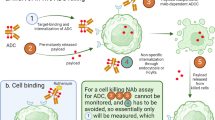Abstract
Purpose
The integrin αvβ3 is expressed on sprouting endothelial cells and on various tumour cell types. Due to the restricted expression of αvβ3 in tumours, αvβ3 is considered a suitable receptor for tumour targeting. In this study the αvβ3 binding characteristics of an 111In-labelled monomeric, dimeric and tetrameric RGD analogue were compared.
Methods
A monomeric (E-c(RGDfK)), dimeric (E-[c(RGDfK)]2), and tetrameric (E{E[c(RGDfK)]2}2) RGD peptide were synthesised, conjugated with DOTA and radiolabelled with 111In. In vitro αvβ3 binding characteristics were determined in a competitive binding assay. In vivo αvβ3 targeting characteristics of the compounds were assessed in mice with SK-RC-52 xenografts.
Results
The IC50 values for DOTA-E-c(RGDfK), DOTA-E-[c(RGDfK)]2, and DOTA-E{E[c(RGDfK)]2}2were 120 nM, 69.9 nM and 19.6 nM, respectively. At all time points, the tumour uptake of the dimer was significantly higher as compared to that of the monomer. At 8 h p.i., tumour uptake of the tetramer (7.40±1.12%ID/g) was significantly higher than that of the monomer (2.30±0.34%ID/g), p<0.001, and the dimer (5.17±1.22%ID/g), p<0.05. At 24 h p.i., the tumour uptake was significantly higher for the tetramer (6.82±1.41%ID/g) than for the dimer (4.22±0.96%ID/g), p<0.01, and the monomer (1.90±0.29%ID/g), p<0.001.
Conclusion
Multimerisation of c(RGDfK) resulted in enhanced affinity for αvβ3 as determined in vitro. Tumour uptake of a tetrameric RGD peptide was significantly higher than that of the monomeric and dimeric analogues, presumably owing to the enhanced statistical likelihood for rebinding to αvβ3.





Similar content being viewed by others
References
Brooks PC. Role of integrins in angiogenesis. Eur J Cancer 1996;32A:2423–2429
Fiedler W, Graeven U, Ergun S, Verago S, Kilic N, Stockschlader M, et al. Vascular endothelial growth factor, a possible paracrine growth factor in human acute myeloid leukemia. Blood 1997;89:1870–1875
Foss HD, Araujo I, Demel G, Klotzbach H, Hummel M, Stein H. Expression of vascular endothelial growth factor in lymphomas and Castelman’s disease. J Pathol 1997;183:44–50
PerezAtayde AR, Sallan SE, Tedrow U, Conners S, Allred E, Folkman J. Spectrum of tumor angiogenesis in the bone marrow of children with acute lymphoblastic leukemia. Am J Pathol 1997;150:815–821
Folkman J. Angiogenesis in cancer, vascular, rheumatoid and other disease. Nat Med 1995;1:27–31
Plow EF, Haas TA, Zhang L, Loftus J, Smith JW. Ligands binding to integrins. J Biol Chem 2000;275:21785–21788
Haubner R, Finsinger D, Kessler H. Stereoisomeric peptide libraries and peptidomimetics for designing selective inhibitors of the αvβ3 integrin for a new cancer therapy. Angew Chem Int Ed Engl 1997;36:1374–1389
Aumailley M, Gurrath M, Muller G, Calvete J, Timpl R, Kessler H. Arg-Gly-Asp constrained within cyclic pentapeptides. Strong and selective inhibitors of cell adhesion to vitronectin and laminin fragment P1. FEBS Lett 1991;291:50–54
Gurrath M, Muller G, Kessler H, Aumailley M, Timpl R. Conformation/activity studies of rationally designed potent anti-adhesive RDG peptides. Eur J Biochem 1992;210:911–921
Janssen ML, Oyen WJ, Dijkgraaf I, Massuger LF, Frielink C, Edwards DS, et al. Tumor targeting with radiolabeled alpha-v-beta-3 integrin binding peptides in a nude mouse model. Cancer Res 2002;62:6146–6151
Johansson SMC, Arnberg N, Elofsson M, Wadell G, Kihlberg J. Multivalent HSA conjugates of 3′-sialyllactose are potent inhibitors of adenoviral cell attachment and infection. Chembiochem 2005;6:358–364
Mammen M, Choi SK, Whitesides GM. Polyvalent interactions in biological systems: implications for design and use of multivalent ligands and inhibitors. Angew Chem Int Ed 1998;37:2754–2794
Joosten JAF, Loimaranta V, Appeldoorn CCM, Haataja S, Ait El Maate F, Liskamp RMJ, et al. Inhibition of Streptococcus suis adhesion by dendritic galabiose compounds at low nanomolar concentration. J Med Chem 2004;47:6499–6508
Goel A, Baranowska-Kortylewicz J, Hinrichs SH, Wisecarver J, Pavlinkova G, Augustine S, et al. 99mTc-labeled divalent and tetravalent CC49 single-chain Fv’s: novel imaging agents for rapid in vivo localization of human colon carcinoma. J Nucl Med 2001;42:1519–1527
Kok RJ, Schraa AJ, Bos EJ, Moorlag HE, Ásgeirsdóttir SA, Everts M, et al. Preparation and functional evaluation of RGD-modified proteins as αvβ3 integrin directed therapeutics. Bioconjugate Chem 2002;13:128–135
Maheshwari G, Brown G, Lauffenburger DA, Wells A, Griffith LG. Cell adhesion and motility depend on nanoscale RGD clustering. J Cell Sci 2000;113:1677–1686
Dijkgraaf I, Boerman OC, Frielink C, Kruijtzer JAW, Liskamp RMJ, Oyen WJ, et al. Synthesis and preclinical evaluation of new αvβ3-integrin binding peptidomimetics for tumor targeting. Eur J Nucl Med Mol Imaging 2004;31 (Suppl 2):S281
Liu S, Cheung E, Ziegler M, Rajopadhye M, Edwards DS. 90Y and 177Lu labeling of a DOTA-conjugated vitronectin receptor antagonist useful for tumor therapy. Bioconjugate Chem 2001;12:559–568
Wu Y, Zhang X, Xiong Z, Cheng Z, Fisher DR, Liu S, et al. MicroPET imaging of glioma integrin αvβ3 expression using 64Cu-labeled tetrameric RGD peptide. J Nucl Med 2005;46:1707–1718
Thumshirn G, Hersel U, Goodman SL, Kessler H. Multimeric cyclic RGD peptides as potential tools for tumor targeting: solid-phase peptide synthesis and chemoselective oxime ligation. Chem Eur J 2003;9:2717–2725
Vrasidas I, André S, Valentini P, Böck C, Lensch M, Kaltner H, et al. Rigified multivalent lactose molecules and their interactions with mammalian galectins: a route to selective inhibitors. Org Biomol Chem 2003;1:803–810
Kiessling LL, Pohl NL. Strength in numbers: non-natural polyvalent carbohydrate derivatives. Chem Biol 1996;3:71–77
Behr TM, Goldenberg DM, Becker W. Reducing the renal uptake of radiolabeled antibody fragments and peptides for diagnosis and therapy: present status, future prospects and limitations. Eur J Nucl Med 1998;25:201–212
Acknowledgements
We thank Gerry Grutters and Hennie Eikholt for technical assistance during animal experiments. All animal experiments were approved by the local animal welfare committee in accordance with the Dutch legislation and carried out in accordance with their guidelines.
Author information
Authors and Affiliations
Corresponding author
Rights and permissions
About this article
Cite this article
Dijkgraaf, I., Kruijtzer, J.A.W., Liu, S. et al. Improved targeting of the αvβ3 integrin by multimerisation of RGD peptides. Eur J Nucl Med Mol Imaging 34, 267–273 (2007). https://doi.org/10.1007/s00259-006-0180-9
Received:
Accepted:
Published:
Issue Date:
DOI: https://doi.org/10.1007/s00259-006-0180-9




